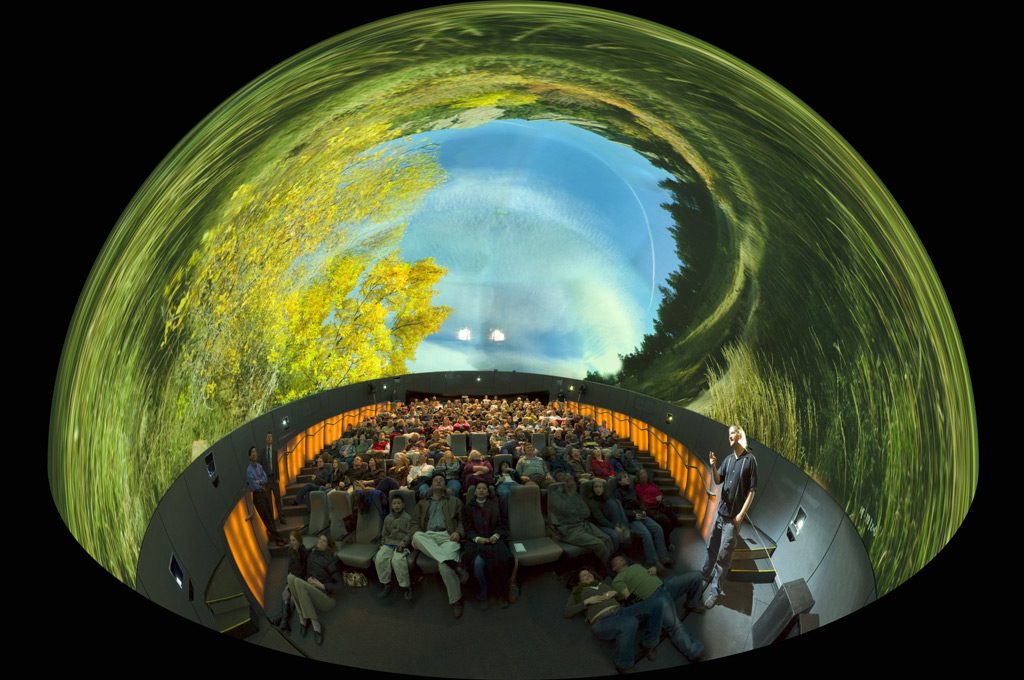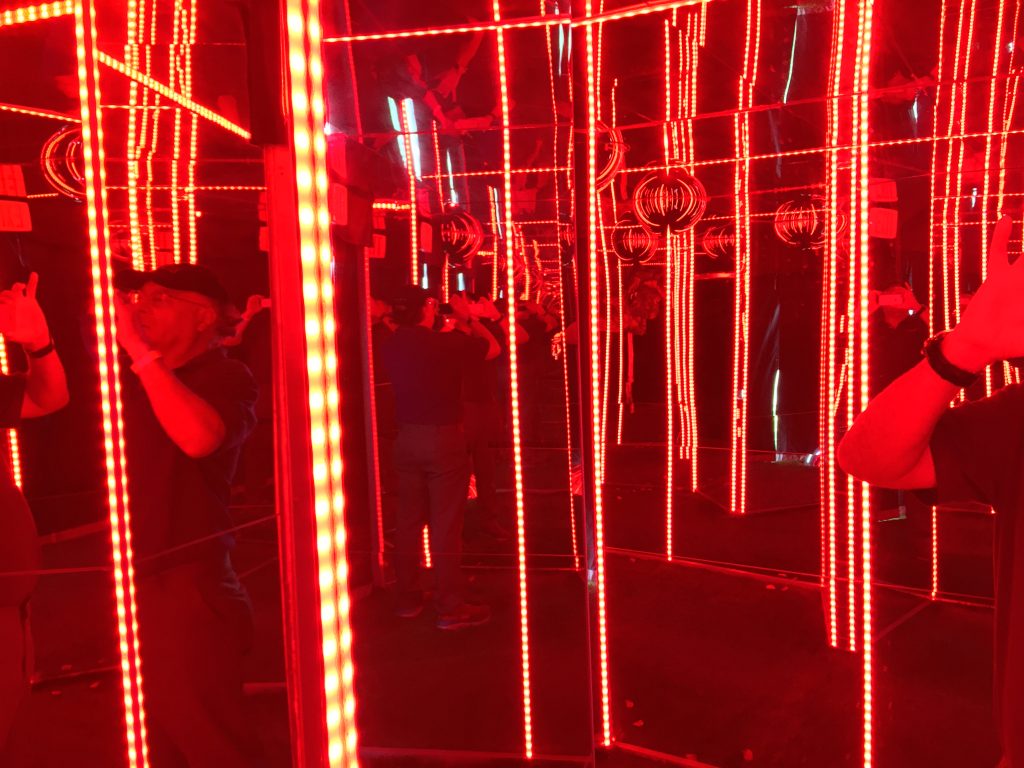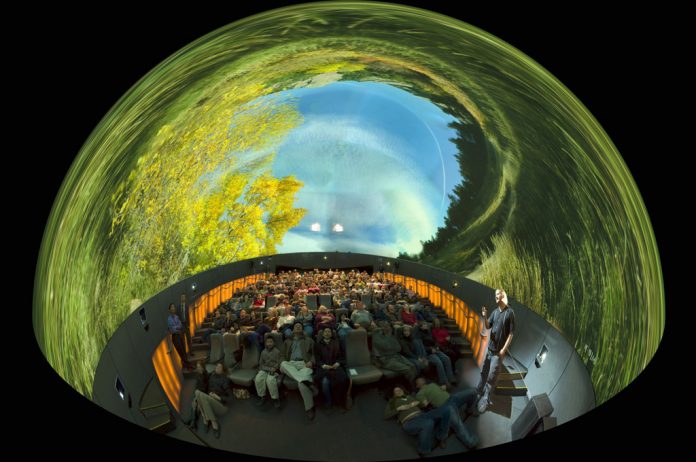At yesterday’s DTLA Film Festival Dome films, which use 360-degree cinematography like Virtual Reality but screen the films in specially built theaters – there were some great films that use this amazing new technology, so that you have the video and sound go all the way around you in every direction- so it’s as close to being at the real scene location as in real life as you can come !
The “Dome Film Series” took place at the Vortex Theater at L.A. Center Studio, and the new Wisdome in the heart of DTLA’s Arts District – which had 5 of these big domes, that are unique – to give you an amazing experience! The biggest of their Domes is 90 feet in Diameter, and can hold 500 people, and the whole area is 35,000 square feet and can hold 1500 people in and outside of the domes !
In 2006 Steven Spielberg said: “Someday, in the not too distant future you’ll be able to go to a movie and the movie will be all around you. The movie will be over your head, it will be 360 degrees around you.”
What’s the Next BIG Thing in film presentation? Answer: “dome films.” Using 360-degree cameral popularized by VR and AR productions, dome filmmakers create a unique, immersive experience by screening the films in specially built dome theaters (not unlike the old school planetariums that can be found in observatories around the country).
In The DTLA Film Festival’s dome film series — the first-ever in Los Angeles — they selected the best films across the globe with a focus on narrative storytelling. The series included several Dome Film World Premieres of narrative features from internationally known filmmakers including Randal Kleiser, Lena Herzog, Robot Koch, Darcelle XV, Jacob Collier, as well the first feature-length dome-film documentary to be released in the U.S. 
Earlier today at the Wisdome Dome Theaters was Neuroplasticity Meditation with Indy Rishi Singh – who formed a circle with the audience and taught us how to use laughter to lower our stress, and improve our health, and become more friendly with other people! Indy Rishi Singh is a wellbeing engineer. He has traveled the world learning from the greatest teachers and scientists in the world. Indy is also on the board of advisors for a revolutionary orphanage in Varanasi, India. He is currently working on developing a wellness app that will change how people approach health and happiness from all walks of life. Learn more about his work at www.iLiving.guru and be the first to try the app at Nola.chat/trial-indy
Then there were 3 Dome films back to back:
Birth of Planet Earth tells the twisted tale of our planet’s origins. Scientists now believe that our galaxy is filled with solar systems, including up to a billion planets roughly the size of our own. The film employs advanced, data-driven, cinematic-quality visualizations to explore some of the greatest questions in science today: How did Earth become a living planet in the wake of our solar system’s violent birth? What does its history tell us about our chances of finding other worlds that are truly Earth-like? Produced by Spitz Creative Media, NCSA’s Advanced Visualization Lab, Thomas Lucas Productions, Inc., in association with Tellus Science Museum. This project has been made possible with support from the Commonwealth of Pennsylvania and the Greater Philadelphia Film Office; funded in part by the National Science Foundation. 
ARORA is a 2019 Reykjavik Planetarium show – An immersive experience about the beauty of Auroras. Take a journey across time and space to understand the science behind the phenomena and to experience the stories of our ancestors. Guided by the lullaby of the Dawn Goddess. This cinematic adventure invites the audience to join the dance of these eerie lights over remote Icelandic landscapes.

Initial approaches to moving fulldome imagery used wide-angle lenses, both 35 and 70 mm film, but the expense and ungainly nature of the film medium prevented much progress; furthermore, film formats such as Omnimax did not cover the full two pi steradians of the dome surface, leaving a section of the dome blank (though, due to seating arrangements, that part of the dome was not seen by most viewers). Later approaches to fulldome utilized monochromatic vector graphics systems projected through a fisheye lens. Contemporary configurations employ raster video projectors, either singly or grouped together to cover the dome surface with full-color images and animations.
Fulldome video projection can use a variety of technologies in two typical formats: single- and multiple-projector systems. The individual projector(s) can be driven by a variety of video sources, typically feeding material rendered in either real-time or “pre-rendered” modes. The end result is a video image that covers an entire domed projection surface, yielding an immersive experience that fills a viewer’s field of view.
Single-projector fulldome video systems use a single (or mixed) video source displayed through a single fisheye lens, typically located at or near the center of a hemispherical projection surface. A single projector has the benefit of avoiding edge blends (see below) between multiple projectors. The main disadvantage of single fisheye systems is that they are limited to the resolution of one projector, and in the smallest dimension of the video image to cover a full dome. Another disadvantage of central projectors is the loss of the center of the dome for optimal viewing of the reconstructed perspective view provided by true hemispheric projection, a problem shared with traditional planetarium projectors. However, this disadvantage fades as audience size increases (everyone cannot be at the center of the dome anyway).
Single-projector mirror systems, pioneered by Mirrordome from Swinburne, but now offered by a plethora of manufacturers, are placed on the edge of the dome to increase seating, decrease costs, and to allow analog planetariums to become digital without giving up their star projector. It is also possible to build such a system at relatively low cost. The main disadvantage is noticeably lower projection quality compared to purpose-built lenses, despite being able to project a higher proportion of the projector resolution.
Multiple-projector fulldome video systems rely on two or more video projectors edge-blended to create a seamless image that covers a hemispherical projection surface; splitting the entire image up into segments allows for higher-resolution imagery and projector placement that does not intrude on the viewing area underneath the dome. A disadvantage of multiple projection is the need to frequently adjust the alignment of projectors and the uneven aging of separate projectors leading to brightness and color differences between segments. Even minor performance differences between projectors can be obvious when projecting a solid color across the entire scene. Edge blended areas where projectors overlap often have some smearing, double images, and can have very obvious additive black level areas if poorly designed or configured.
A wide variety of video projection technologies has been employed in domes, including cathode ray tube (CRT), Digital Light Processing (DLP), liquid crystal display (LCD), liquid crystal on silicon (LCOS), and most recently, two varieties of laser projectors (see the laser video projector).
For multi-projector systems, in particular, display devices must have a low black level (i.e., project little or no light when no signal is sent to them) to allow for reasonable edge-blending between the different projector footprints. Otherwise, overlapping video images will have an additive effect, causing a complex pattern of grey to appear even when no image is being projected. This becomes particularly important for users in the planetarium field, who have a vested interest in projecting a dark night sky. The desire for projectors to “go to black” has resulted in continued use of CRT technology, even as newer and less expensive technologies have emerged.
LCD projectors have fundamental limits on their ability to project true black as well as light, which has tended to limit their use in planetariums. LCOS and modified LCOS projectors have improved on LCD contrast ratios while also eliminating the “screen door” effect of small gaps between LCD pixels. “Dark chip” DLP projectors improve on the standard DLP design and can offer a relatively inexpensive solution with bright images, but the black level requires physical baffling of the projectors. As the technology matures and reduces in price, laser projection looks promising for dome projection as it offers bright images, large dynamic range and a very wide color space.
DOME lenses and standard lens are similar in some ways. They both depend on the type of display device, LCD, DLP, LCOS, DILA and the size chip or panel that is part of this device. The unique feature of the DOME lens is the actual shape of the glass, the projected image spill out from the top and all around the circumference of the lens. The biggest advantage is how this type of lens maintains focus over the full 180 x 180 field of view. A single standard flat field or curved field lens would have major focus and distortion issue. Several lens developers offer DOME lenses with each designed to a specific projector class and a display device. These lenses can cover a variety of pixel sizes and display resolutions.
Computer Generated (CG) content is the main source of material for Fulldome. CG content can be live simulator output, such as from planetarium simulation software, or prerecorded fulldome video. Live-Action FullDome videos are becoming more available for dome use as digital video camera resolutions increase.















